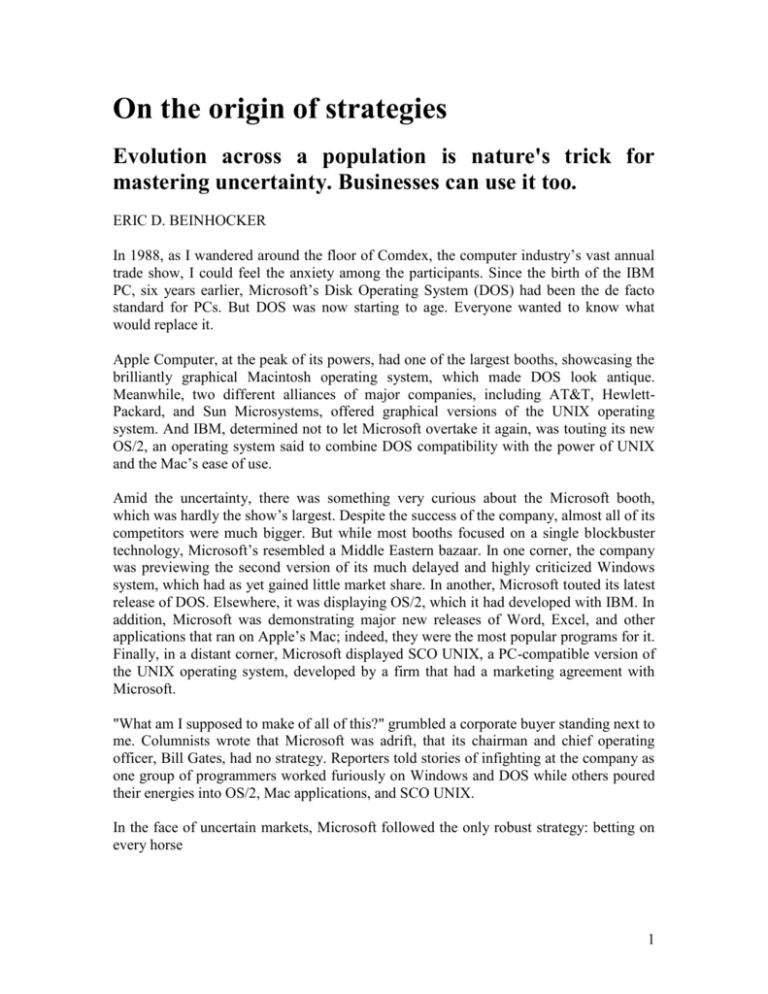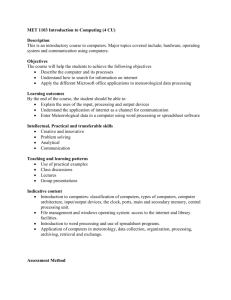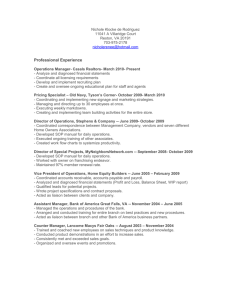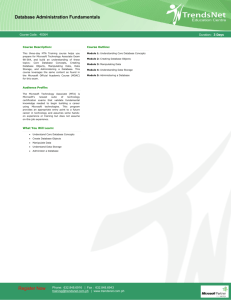
On the origin of strategies
Evolution across a population is nature's trick for
mastering uncertainty. Businesses can use it too.
ERIC D. BEINHOCKER
In 1988, as I wandered around the floor of Comdex, the computer industry’s vast annual
trade show, I could feel the anxiety among the participants. Since the birth of the IBM
PC, six years earlier, Microsoft’s Disk Operating System (DOS) had been the de facto
standard for PCs. But DOS was now starting to age. Everyone wanted to know what
would replace it.
Apple Computer, at the peak of its powers, had one of the largest booths, showcasing the
brilliantly graphical Macintosh operating system, which made DOS look antique.
Meanwhile, two different alliances of major companies, including AT&T, HewlettPackard, and Sun Microsystems, offered graphical versions of the UNIX operating
system. And IBM, determined not to let Microsoft overtake it again, was touting its new
OS/2, an operating system said to combine DOS compatibility with the power of UNIX
and the Mac’s ease of use.
Amid the uncertainty, there was something very curious about the Microsoft booth,
which was hardly the show’s largest. Despite the success of the company, almost all of its
competitors were much bigger. But while most booths focused on a single blockbuster
technology, Microsoft’s resembled a Middle Eastern bazaar. In one corner, the company
was previewing the second version of its much delayed and highly criticized Windows
system, which had as yet gained little market share. In another, Microsoft touted its latest
release of DOS. Elsewhere, it was displaying OS/2, which it had developed with IBM. In
addition, Microsoft was demonstrating major new releases of Word, Excel, and other
applications that ran on Apple’s Mac; indeed, they were the most popular programs for it.
Finally, in a distant corner, Microsoft displayed SCO UNIX, a PC-compatible version of
the UNIX operating system, developed by a firm that had a marketing agreement with
Microsoft.
"What am I supposed to make of all of this?" grumbled a corporate buyer standing next to
me. Columnists wrote that Microsoft was adrift, that its chairman and chief operating
officer, Bill Gates, had no strategy. Reporters told stories of infighting at the company as
one group of programmers worked furiously on Windows and DOS while others poured
their energies into OS/2, Mac applications, and SCO UNIX.
In the face of uncertain markets, Microsoft followed the only robust strategy: betting on
every horse
1
Although the outcome of this story is now well-known, to anyone standing on the
Comdex floor in 1988, it wasn’t obvious which operating system would win. In the face
of this uncertainty, Microsoft followed the only robust strategy: betting on every horse.
Bill Gates wanted Windows to win. Yet if DOS had continued to dominate, he would
have continued to supply it. If OS/2 had triumphed, he would have shared the wealth with
IBM. Had the Mac emerged victorious, he would have lost the war for operating systems
but won in applications. Had UNIX become the standard, Microsoft would have also no
longer been the major player in operating systems, but with its hand in SCO UNIX, it
could at least have remained a contender. Besides betting on all these horses, Gates took
steps that would pay off no matter which of them came in first—investing heavily, for
example, in graphical-interface design skills and object-oriented programming.
The same pattern is evident today in Gates’s approach to the Internet. Microsoft’s evershifting portfolio of development projects, investments, and acquisitions—as well as the
company’s many joint ventures with software, cable, telecommunications, and
communications media companies—looks confusing if you ask, "What is Microsoft’s
strategy?" It makes more sense to ask, "What are Microsoft’s strategies?"
Predicting the unpredictable
Strategy has traditionally been a high-stakes game that started when a management team
developed a vision of the company’s future environment. The team then made big, hardto-reverse decisions about where the company would focus its energies, its capital, and its
people. Finally, the team hoped and prayed that its vision was correct.
But the whole idea of predicting the future is troublesome. Managers intuitively know
that competitive environments are often difficult to foresee. New work by scientists and
economists shows that business markets may be even more fundamentally unpredictable
than intuition suggests and that they may be subject to the same laws governing other socalled "complex systems," such as galaxies, ecosystems, insect colonies, brains, and the
Internet. Recently, scientists have gained a better understanding of these systems, which
comprise many dynamically interacting parts.1
An important property of such systems is the inherent difficulty of predicting how they
will behave. As our limited success in predicting the course of the weather and the stock
market shows, past patterns of behavior are not always reliable guides to the future. The
properties of complex adaptive systems present particular challenges to the development
of business strategy because people have a natural tendency to look for patterns. Indeed,
the human drive to find patterns is so strong that they are often read into perfectly random
data. Moreover, human beings like to assume that cause directly precedes effect, which
makes it difficult to anticipate the second-, third-, and fourth-order effects of path
dependence. If businesses are indeed complex systems, one cannot rely on the ability to
find patterns and make predictions. A better way to manage uncertainty is needed.
2
Strategy as evolutionary search
For clues about how to develop strategies in an uncertain world, look to another complex
system, where strategy is a matter of life and death: the world of living species in their
evolutionary fight for survival. Nature teems with examples of ingenious strategies that
have proved quite adaptive in complex environments. Evolutionary biologists have
developed tools to understand the way nature develops its strategies, and these tools can
also help businesspeople think about business strategies.
The key to nature’s ability to develop strategies in the face of uncertainty is the fact that
evolution occurs not in individuals but across populations. A species is always a
population of strategies, with new adaptations, or experiments, constantly emerging.
Likewise, businesses should cultivate evolving populations of strategies, much as
Microsoft did in 1988.
To understand how populations evolve, scientists use "fitness landscapes": imaginary
three-dimensional grids with surfaces of peaks and valleys.2 Each point on the grid
represents a possible gene combination of a particular species, and any point’s height
indicates that combination’s fitness for survival. Adjacent points represent gene
combinations that are only slightly different (Exhibit 1). To understand how to frame
strategies in the business world, replace "species" with "company" and "gene
combinations" with "business strategies." One point on the grid, for instance, might
represent a strategy of "focusing on US customers with a narrow product offering."
Another might represent "selling globally with a broad one-stop-shop product line." The
height of each point on the grid would represent that strategy’s profitability, positive or
negative.
In the evolutionary struggle, species search for the high points on their fitness landscapes,
which can assume various forms. Stuart Kauffman, of the Santa Fe Institute and the Bios
Group, points to a "Mount Fuji" landscape, with a single steep peak representing a
strategy superior to all others. On such a landscape, nearby points (representing similar
strategies) have similar altitudes, or levels of fitness. At the other extreme would be a
3
perfectly random landscape of peaks and valleys, where there is no one optimal strategy,
and neighboring points, representing similar strategies, might have radically different
levels of fitness.
Most complex systems—biological and commercial alike—don’t embody either extreme:
they may include many peaks and valleys, like random landscapes, but nearby points tend
to have similar levels of fitness, like the Mount Fuji example. Such a "rugged" landscape
has not only hills and valleys but also regions of alpine highlands and coastal lowlands.
Of course, both biological and business landscapes are not static; they buckle and heave
as competitive conditions shift.
Surviving in the fog
To carry the analogy further, a business strategist can be regarded as the leader of an
expedition to find the highest elevations on a company’s fitness landscape. Fog prevents
the "hikers" from seeing more than a few feet in front of themselves, and the landscape
keeps changing. Biologists have identified key rules that evolution uses to find high
peaks. Managers too can use them.
The first rule is that evolutionary searches never sit still. No matter how successful a
strategy is at a given moment, a species or a business must experiment constantly to find
something better. In nature, genes are constantly subject to mutation and recombination.
In business, the expedition should always be on the move to find new directions upward.
Another key principle is parallelism: the entire expedition should not explore the same
region. Instead, many search parties should spread out from the "base camp" to explore
the shifting terrain and bring back news of discoveries. In nature, evolutionary searches
are massively parallel, for each member of the population is a unique experiment
searching through a slightly different point on the landscape. The more places the search
parties explore, the more likely they are to find a new, higher peak (Exhibit 2), so the
more explorers go out searching, the more likely it is that someone will have located a
good spot when the site of the expedition’s base camp starts collapsing. Finally, the
deployment of many small search parties lets the expedition pursue a few high-risk
hunches because each party is somewhat expendable.
4
A good example of business parallelism in action comes from the highly successful credit
card company Capital One, which routinely generates large numbers of new ideas, tries
them out in the marketplace, backs the winners, and unsentimentally kills off the losers.3
The company, for instance, is using its skills in data mining and direct marketing to resell
mobile phones—a risky experiment that will quickly help it determine if this is an
attractive new spot in the landscape. But most companies resist parallelism, which can be
expensive, seems inefficient, and sometimes puts people at cross-purposes by creating
internal competition.
Of course, randomly sending out dozens of search parties is unwise, for no matter how
large the expedition, there is likely to be too much ground. Some of the explorers should
therefore embark on what mathematicians and biologists call an "adaptive walk," or "hill
climbing," by taking a step, peering through the fog for the steepest uphill path, taking a
step in that direction, looking around again, taking another step, and so on. In biological
evolution, genetic mutation provides that sort of incremental variation.
This approach works well in regions where high ground tends to lie near other high areas.
But once adaptive walkers arrive at the topmost point in a vicinity, they will be stuck
there, since the next step leads downhill even if a much higher peak looms in the fog just
over a nearby valley. Some search parties should therefore follow a different strategy.
Suppose they had powerful "pogo sticks" permitting them to hop to more distant points.
In biological evolution, sexual reproduction supplies this ability to take longer leaps
across a landscape. Unfortunately, though the pogo stick gives the explorers a chance to
find higher peaks, the fog makes it hard for them to predict where they will land. Since
the highest peaks tend to be near one another, the farther the jump, the greater the chance
of losing rather than gaining altitude.
5
Adaptive walks ensure that most of the time the explorers are heading toward a higher
level of fitness
The best strategy for searching a rugged fitness landscape is to intersperse adaptive walks
with occasional medium- or long-distance pogo jumps—an idea that not only can be
proved mathematically and in computer simulations but also makes intuitive sense.
Adaptive walks ensure that most of the time the explorers head toward a higher level of
fitness. Jumps on the pogo stick keep them from getting stuck on local peaks and
occasionally yield significant improvements, at the cost of occasional declines in fitness.
In nature, a species’s experiments tend to be incremental; most of the population explores
ground relatively close to the base camp. Although long-distance jumps involve a smaller
part of the population, they provide very valuable protection against sudden shifts in the
landscape, for in biological systems, a few genetically atypical individuals may survive a
sudden environmental change that kills off typical individuals. The same is true in
business. A company should use most of its resources to build its current business, but
the resources devoted to riskier experiments further afield are also critically important,
since such experiments could contain the seeds of success in a currently unimaginable
future.4
The Finnish telecom company Sonera, for example, mixes short and long jumps by
making adaptive-walk improvements in its core fixed-line and mobile-telephone
businesses while also placing long-jump bets at the frontiers of a market that doesn’t yet
exist: the intersection of mobile telephony and the Internet.
Yes, your company can do this
The implicit metaphor and mind-set of strategy has been military: you set a clear
objective and then focus all your energies on "taking that hill." In this view, strategy is
about setting objectives, narrowing options, and making choices. But complexity theory
teaches that, in reality, the hill might not be there tomorrow.
In an uncertain world, strategy is really about creating options and opening up new
choices, not shutting them down. True, resources are finite, so trade-offs and
commitments are inevitable. To continue the mountaineering analogy, decisions have to
be made about where to put the base camp each night and where to send search parties.
But these decisions are much more likely to be successful in the rugged, foggy landscape
if search parties bring back lots of choices and information. Many companies have to
make big bets because they haven’t sent out sufficient numbers of search parties.
Companies that avoid this pitfall do things differently; as executives at Capital One put it,
"We don’t like to make big bets. If we are making a big bet, it probably means we failed
somewhere earlier." This emphasis on exploration and opening up options is very
different from what most companies actually do.
A common objection to the evolutionary approach is the idea that a company can’t afford
to bet on everything. Maybe Microsoft can make multiple bets, but other companies
6
can’t. Actually, in 1988 Microsoft was smaller than just about all of its competitors.
Besides, if you were going to make a bet today on what kind of company will eventually
win on the Internet—a large incumbent technology company or a leading venture capital
firm—which would you bet on? Probably the latter, for though it would have much less
money to spend than the incumbent, it would be exploring much more of the terrain.
Resources are rarely the constraint on parallelism and experimentation; the real problems
are mind-sets and cultures. Instead of asking if you can afford to do something, ask if you
can afford not to do it.
You might also ask if there isn’t a risk that companies will get involved with businesses
they don’t understand, as many did in the 1970s. That decade’s diversification craze was
about assembling conglomerates of unrelated businesses to diversify industry sector risk.
I am not advocating that here. Searching the fitness landscape implies rather that a
company should cultivate a portfolio of strategic experiments in a business it knows.
Although some of them may be risky and different from the current business, they
leverage core skills and assets. As Microsoft, for instance builds its Internet business, it
has become involved with media, content, and communications ventures that expand the
bounds of its business but also leverage its brand name and its core skills in software
while helping it build new ones.
Another objection to the evolutionary approach is that it may be fine for businesses like
software or credit cards but not for those requiring heavy capital expenditures. How many
experiments can an electric utility, for example, afford to run? Actually, in view of the
global trend to deregulation, an electric utility can’t afford not to conduct many
experiments as the landscape buckles and heaves around it. Although it is true that in
some businesses the minimum size of experiments may be relatively large, not all search
parties, even in such businesses, must be large; there simply has to be a sufficient number
of experiments with a sufficient spread across the landscape. However, once a business—
particularly a capital-intensive business—finds promising vantage points, it must be able
to ramp up the resources it devotes to them quickly.
Getting an organization to think about strategy in this way isn’t easy. It forces people to
deal with ambiguity and creates internal tensions as the company simultaneously pursues
what may be contradictory paths. Most corporate processes, metrics, and incentives
reflect the "take that hill" view of strategy. They must change.
Invest in diversity
Pursuing a diverse portfolio of strategies requires a diverse mixture of people to
contribute ideas. Diversity of experience—as well as of age, sex, race, national origin,
and so forth—is therefore crucial. General Electric, for instance, deliberately hires
employees from a variety of talent pools and then exposes those people to more than one
GE business rather than leave them to climb the career ladder in a particular unit.5
Actively cultivating diversity in this way may seem—indeed, may be—inefficient in the
short run, but the dangers of inbreeding are as great in business as in nature.
7
Value strategies as if they were options
The metrics most commonly used to evaluate new investments are net present value
(NPV), payback period, operating profit, and return on capital. They share a common
flaw: failing to account for the option value of each investment—the possibility that it
could create further opportunities in the future. Since there is real value in having a wide
array of choices, which provide flexibility in an uncertain world, companies should
account for this value. Fortunately, significant progress has been made in giving a
company’s strategic options values that can be incorporated into business decision
making.6
Categorize the mix of strategies
Managers should ask whether their strategy portfolios embody a healthy mix of small and
long jumps. Strategies should thus be categorized along three dimensions: time (payoffs
in the near, medium, or long term), risk (low, medium, or high), and aim (expanding or
defending a current business, building a new one that has already been identified, or
laying the foundations for potential new businesses).
Stress-test your strategies
To ensure that a population of strategies covers sufficiently broad and promising regions
of the fitness landscape, ask questions that test for robustness. What are the likely
scenarios in the industry? Which of them is best for the company, and how can its
strategies push the industry in that direction? How would the company adapt to the other
most likely scenarios? Which of them, likely or not, presents major threats or
opportunities? Is the company preparing itself for highly unlikely scenarios, or does it
accept the risk of being unprepared for them? Classical scenario analysis, 7 systems
dynamics modeling,8 and new frameworks for categorizing and managing uncertainty9
can help a company stress-test its strategy portfolio.
Bring the market inside
As much as possible, selection pressures on a company’s population of strategies should
reflect marketplace pressures. In reality, however, investment dollars often flow to
projects favored by people who hold political power or who generated yesterday’s
revenues rather than tomorrow’s possibilities. To overcome this pattern, Lucent
Technology’s new internal-venture arm gains external market valuation for some of its
internal start-ups by inviting venture capitalists to participate, and it may eventually float
pieces of new businesses in initial public offerings.
Moreover, many companies protect egos, turf, and careers by clinging to nonperforming
strategies. Capital One tries to avoid this problem by shutting down unsuccessful
experiments, but it is careful to distinguish between ideas that failed though they were
implemented well, on the one hand, and failed people, on the other.
8
Use venture capital performance metrics
Many companies use the same performance metrics for a mature factory that makes
widgets in Ohio and a start-up Internet operation in India. It makes sense to measure
short-jump investments through traditional financial returns such as profits and return on
investment, but long-jump investments, like those of venture capitalists, should be
measured through market acceptance, meeting milestones, growth, market capitalization,
and so forth.
History is littered with great companies that failed to move as the landscapes around them
changed. They hunkered down in the base camps of their traditional strategies as their
formerly high peaks collapsed, and since they had not adequately explored the landscapes
around them, they didn’t know where to go. By fashioning an evolving population of
strategies, managers can improve the odds that they will avoid the strategic Death Valleys
and enjoy the rewards found on the strategic peaks.
About the Author
Eric Beinhocker is a principal in McKinsey’s London office. This article is adapted from
"Robust adaptive strategies" by Eric D. Beinhocker, Sloan Management Review, spring
1999, pp. 95-106. Reprinted by permission of the publisher. Copyright © 1999 Sloan
Management Review Association. All rights reserved. This version of the article was first
published in The McKinsey Quarterly, 1999 Number 4.
9








